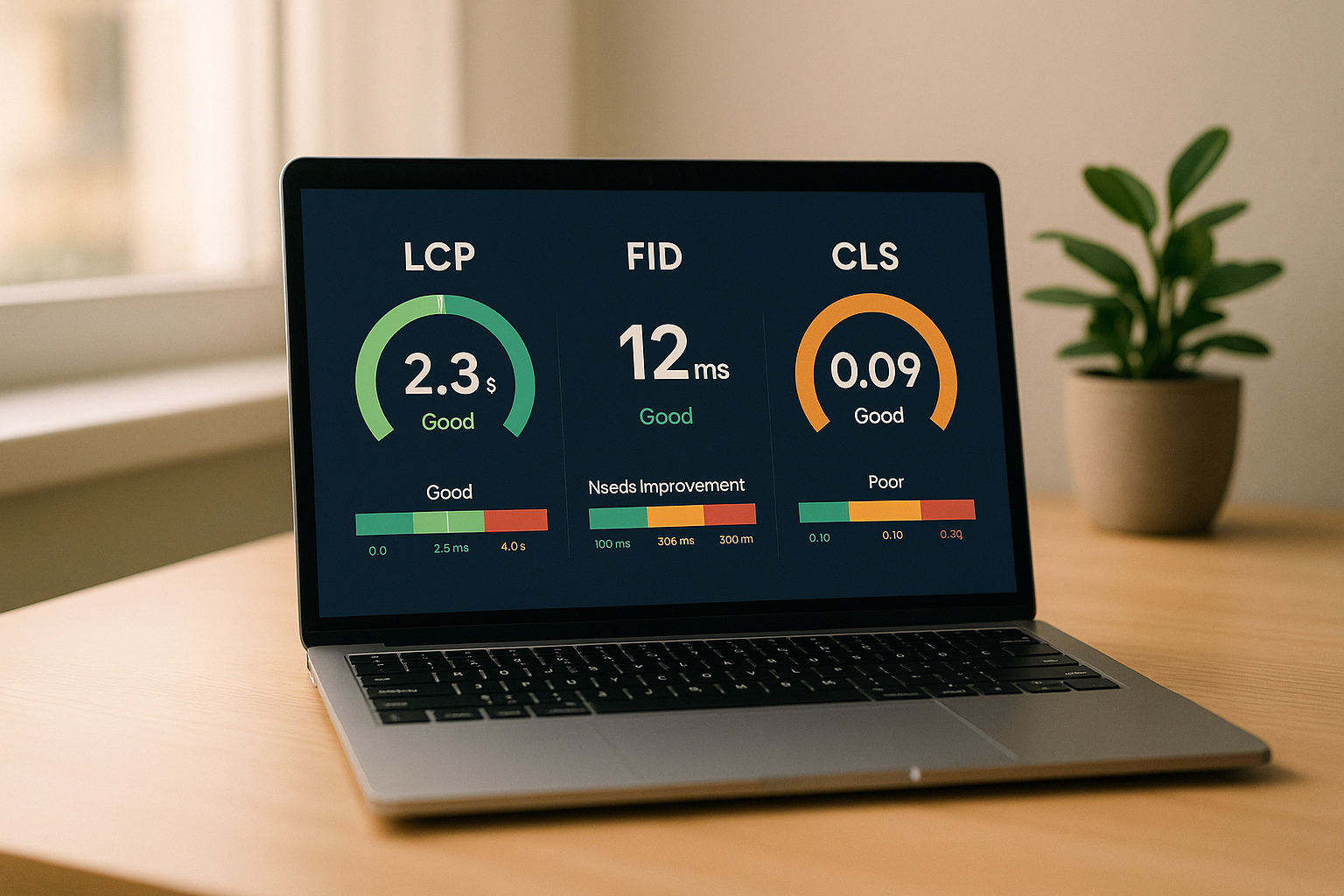Distributing content across platforms can be time-consuming and inconsistent. AI tools simplify this process, saving time and ensuring consistent messaging. These tools handle tasks like scheduling, repurposing content, targeting audiences, and analyzing performance. Below are seven AI tools that can help you streamline your content distribution strategy:
- Distribution AI: Converts content into multiple formats tailored for platforms. Offers a free trial and flexible pricing for businesses of all sizes.
- Narrato: Combines content creation and distribution with AI writing, image generation, and workflow management. Integrates with platforms like WordPress and Webflow.
- Synthesia: Creates videos from text using AI, with multilingual support and tiered pricing for individuals and enterprises.
- Pictory AI: Turns written content into professional videos, supports batch processing, and offers flexible credit-based pricing.
- Vidyo.ai (Quso.ai): Transforms long videos into short clips for social media with automated captions and scheduling tools.
- Outbrain: Distributes content as native ads across premium publisher networks, using performance-based pricing.
- Taboola: Optimizes content placement through native advertising with cross-device targeting and real-time analytics.
These tools cater to different needs, from social media automation to native advertising, and offer pricing models suitable for various business sizes.
Quick Comparison:
| Tool | Focus | Key Features | Pricing Model | Best For |
|---|---|---|---|---|
| Distribution AI | Multi-platform automation | Repurposing, scheduling | Subscription-based | Social media managers |
| Narrato | Content creation & distribution | AI writing, workflow tools | Tiered monthly plans | Content teams |
| Synthesia | Video content creation | Text-to-video, multilingual | Credit-based or monthly | Training & marketing teams |
| Pictory AI | Video from text | Auto video generation | Credit-based system | Marketers repurposing blogs |
| Vidyo.ai (Quso.ai) | Short-form video creation | Clip generation, captions | Usage-based pricing | Social media creators |
| Outbrain | Native advertising | Premium publisher network | Cost-per-click (CPC) | Brands driving traffic |
| Taboola | Content discovery | Real-time optimization | Cost-per-click (CPC) | Advertisers with budgets |
Each tool offers unique benefits based on your content distribution goals, budget, and technical needs.
What effective content distribution actually looks like with Ross Simmonds @ Foundation
1. Distribution AI
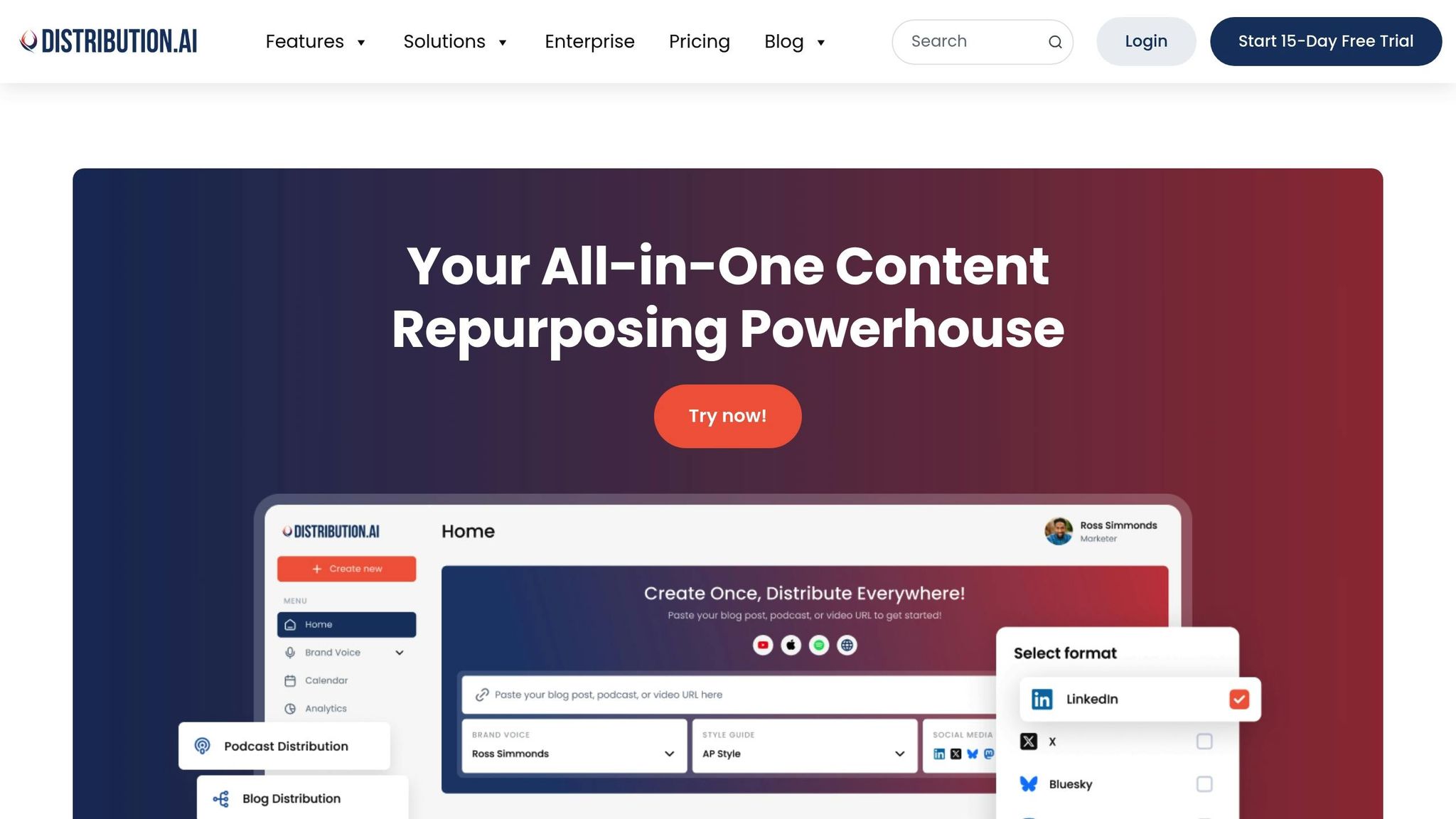
Distribution AI takes a single piece of content - a blog post, podcast, or video - and transforms it into multiple formats tailored for various digital platforms. It’s all about saving time and ensuring your content fits seamlessly across different channels.
How It Works
This tool specializes in repurposing content, fine-tuning it for each platform. For instance, a blog post could be turned into social media snippets, an email newsletter, or even a video script, all optimized for specific audiences and platforms.
Flexible Pricing and Options for Growth
Distribution AI offers a 15-day free trial, giving businesses a chance to explore its features risk-free. If you exceed the plan's limits, you can either pay a small overage fee or upgrade to a bigger plan. There are no long-term contracts, and an Enterprise option is available for larger organizations. This setup makes it a great fit for both small businesses and companies looking to expand their reach.
With its adaptable pricing and platform-specific features, Distribution AI is designed to meet the needs of businesses at every stage of growth.
2. Narrato
Narrato is an all-in-one AI-powered platform designed to simplify content creation and distribution, making it easier to manage workflows from start to finish. Here's a closer look at how its features support efficient multi-channel content distribution.
Transforming Content for Different Platforms
Narrato's AI engine makes repurposing content a breeze. With the Business plan, users get unlimited AI writing (up to 1,250,000 characters per user), allowing teams to adapt a single piece of content into multiple formats - blog posts, social media updates, email campaigns, or marketing materials - while maintaining a consistent brand voice.
The plan also includes AI image generation, offering 200 images per month, with an additional 50 images per extra user.
Automated Multi-Channel Distribution
Narrato simplifies content distribution with built-in integrations for WordPress and Webflow, unlimited social media account grouping, and API/Zapier connectivity, enabling seamless automation across platforms.
Performance Tracking and Analytics
With the Business plan, users can take advantage of unlimited revision history and customizable workflows. It also includes up to 100 SEO content briefs per month (plus 25 per additional user), helping teams fine-tune their content for better performance before publishing.
Flexible Pricing for All Business Sizes
Narrato offers a tiered pricing model to accommodate various business needs:
- Free Plan: $0/month, includes 2 free members and basic AI features with 2,000 AI characters per user each month.
- Pro Plan: $36/month (billed annually) or $48/month (billed monthly). Designed for small teams and solo creators, this plan supports 4 user seats (additional users cost $9/month each) and offers 400,000 AI characters per month.
- Business Plan: $96/month (billed annually) or $124/month (billed monthly). This plan includes 4 user seats (additional users cost $24/month each) and provides unlimited AI writing (with fair usage limits), white-labeling, freelancer payment management, direct publishing to WordPress/Webflow, API and Zapier integration, unlimited social media accounts, advanced analytics, and SEO content briefs.
"Narrato pricing scales up and down with the number of active users on your workspace."
- Narrato Pricing Plans
For businesses with unique needs, Narrato offers custom plans tailored to scenarios like enterprise-level operations, single-user setups, bulk AI content generation, small agencies, or unlimited user access. This adaptability has earned Narrato Workspace a 5-star rating from 20 reviews on Software Finder.
"Narrato is ideal for small businesses. It offers user-friendly content management, seamless collaboration, and efficient workflow tools. Small teams can easily create, edit, and organize content, boosting productivity and ensuring consistency. With its affordable pricing and intuitive interface, Narrato simplifies content creation and management, making it a perfect fit for small business needs."
- Shadin Digital Info, Tech Enthusiast
3. Synthesia
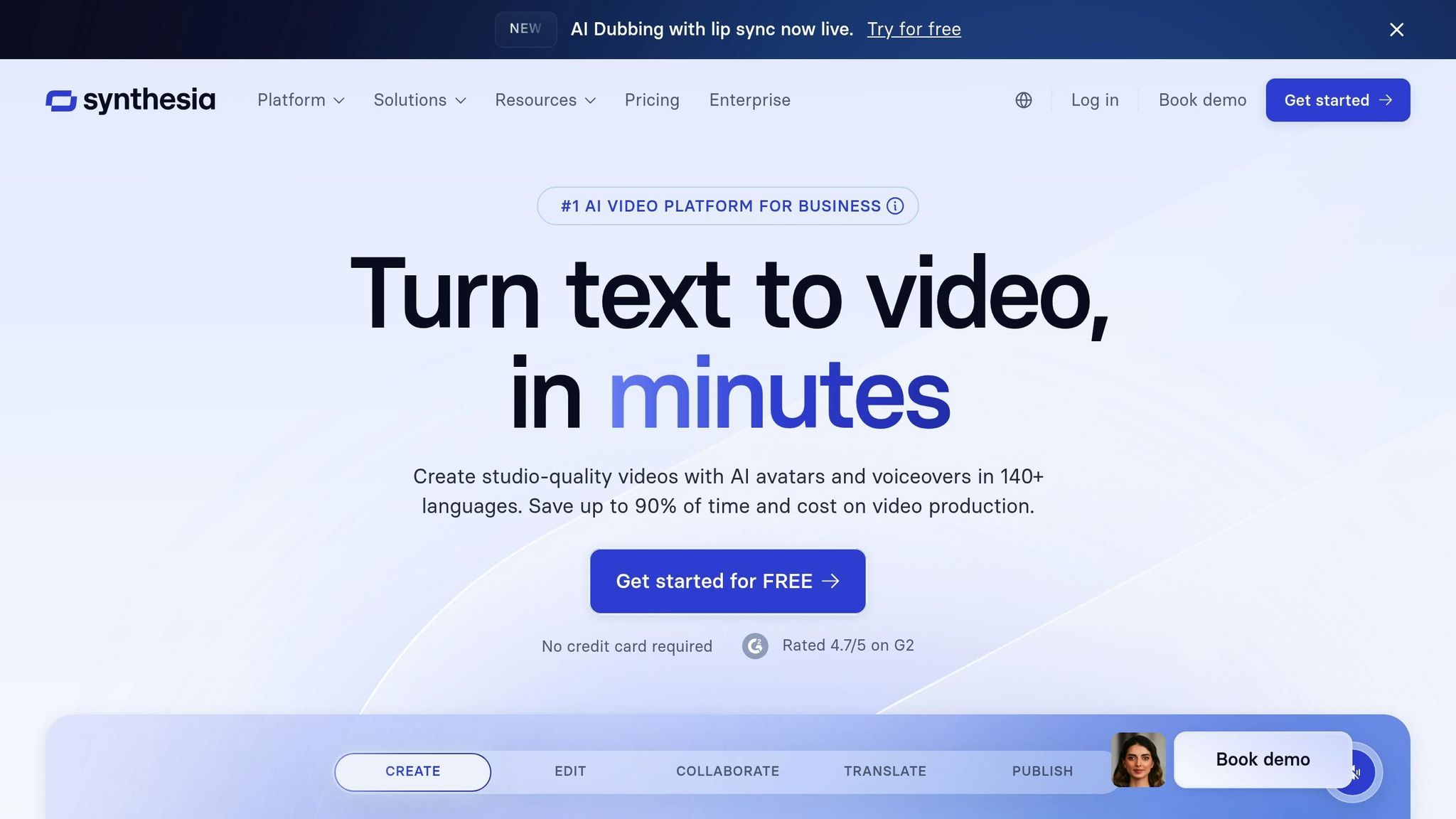
Synthesia is an AI-driven platform that transforms text into video presentations, making it easier to incorporate video into your content strategy.
Pricing and Options for Businesses
Synthesia uses a tiered pricing structure designed to accommodate individuals, small teams, and large enterprises. The platform operates on a credit-based system, where creating videos consumes credits depending on the video's length and complexity. Personal plans are tailored for individual users and smaller teams, while enterprise-level plans come with perks like priority support, more generous credit allowances, and enhanced collaboration tools.
For businesses needing a large volume of video content, some plans include unlimited video generation, which can be a cost-effective alternative to traditional video production. However, it's worth noting that unused video minutes don’t carry over, so careful planning is essential to maximize value.
This flexibility makes Synthesia a great fit for marketing teams, training departments, and content agencies. Up next, we’ll dive into another tool that simplifies content distribution even further.
4. Pictory AI
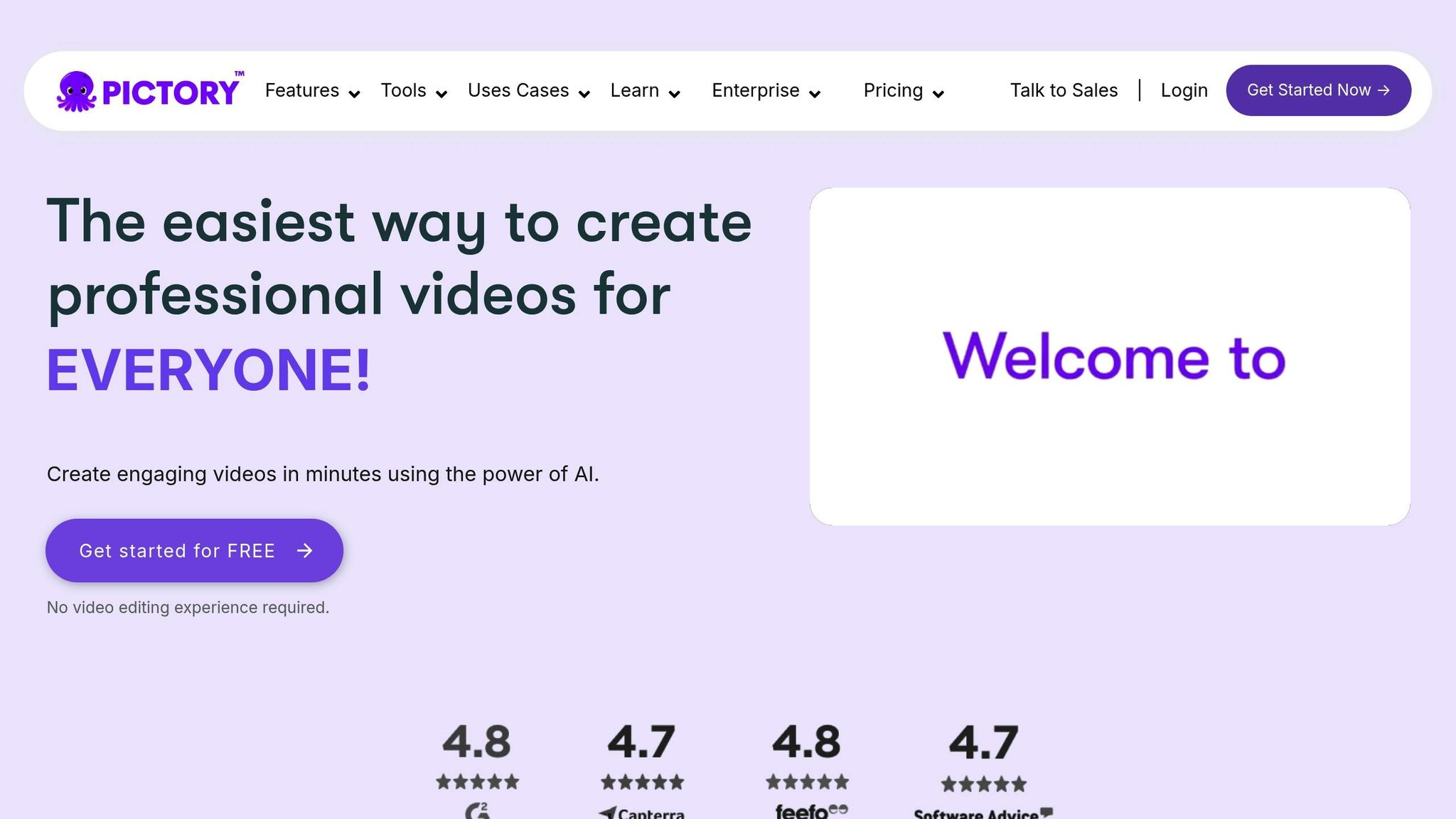
Pictory AI takes content repurposing to the next level by converting written content into professional-grade videos. This tool simplifies video marketing by leveraging artificial intelligence to turn blog posts, articles, and scripts into engaging video content. It's a game-changer for marketers looking to reuse existing material without starting from scratch.
Transforming Text into Video
Pictory AI specializes in turning text-based content into polished videos. It can automatically extract key points from blog posts, break them into scenes, and pair them with relevant visuals - all in just a few minutes.
The platform supports both article-to-video and script-to-video formats. It even offers AI-generated voiceovers and access to a library of over 3 million stock clips. If you have existing audio content, such as podcasts, Pictory AI can enhance it by adding visuals, captions, and branded graphics. This feature is especially handy for creating bite-sized social media videos from longer audio recordings.
Streamlined Multi-Channel Distribution
Although Pictory AI's primary focus is video creation, it integrates seamlessly with major social media platforms and content management systems. Videos can be exported in square, vertical, or landscape formats, making them ideal for platforms like Instagram, TikTok, YouTube, and LinkedIn.
The tool also generates captions tailored for different social media formats. You can customize the font, color, and placement of these captions to align with your branding. For teams managing multiple campaigns, Pictory AI supports batch processing, enabling the creation of numerous videos from various content pieces simultaneously.
Performance Insights and Analytics
Pictory AI includes basic analytics to help users optimize their video content. Features like A/B testing for thumbnails and titles make it easier to identify what works best. Additionally, the platform tracks the performance of different content transformations, allowing users to fine-tune their video creation strategies over time.
Flexible Pricing for All Business Sizes
Pictory AI offers a subscription-based pricing model with options to suit businesses of all sizes:
- Standard Plan ($19/month): Includes 30 video credits, access to the stock media library, and basic editing tools. One video credit typically covers a 10-minute video, with shorter videos using fewer credits.
- Premium Plan ($39/month): Provides 60 video credits and adds features like custom branding, priority processing, and advanced text-to-speech capabilities.
- Teams Plan ($99/month): Designed for larger organizations, this plan includes 90 video credits, team collaboration tools, and API access for seamless workflow integration.
Unused video credits roll over for up to 12 months, making the plans flexible for businesses with irregular content schedules. For enterprises with higher demands, Pictory AI offers custom pricing options, unlimited video generation, and dedicated account management. Annual subscriptions come with discounts of up to 20%, offering additional savings compared to monthly billing.
sbb-itb-5be333f
5. Vidyo.ai
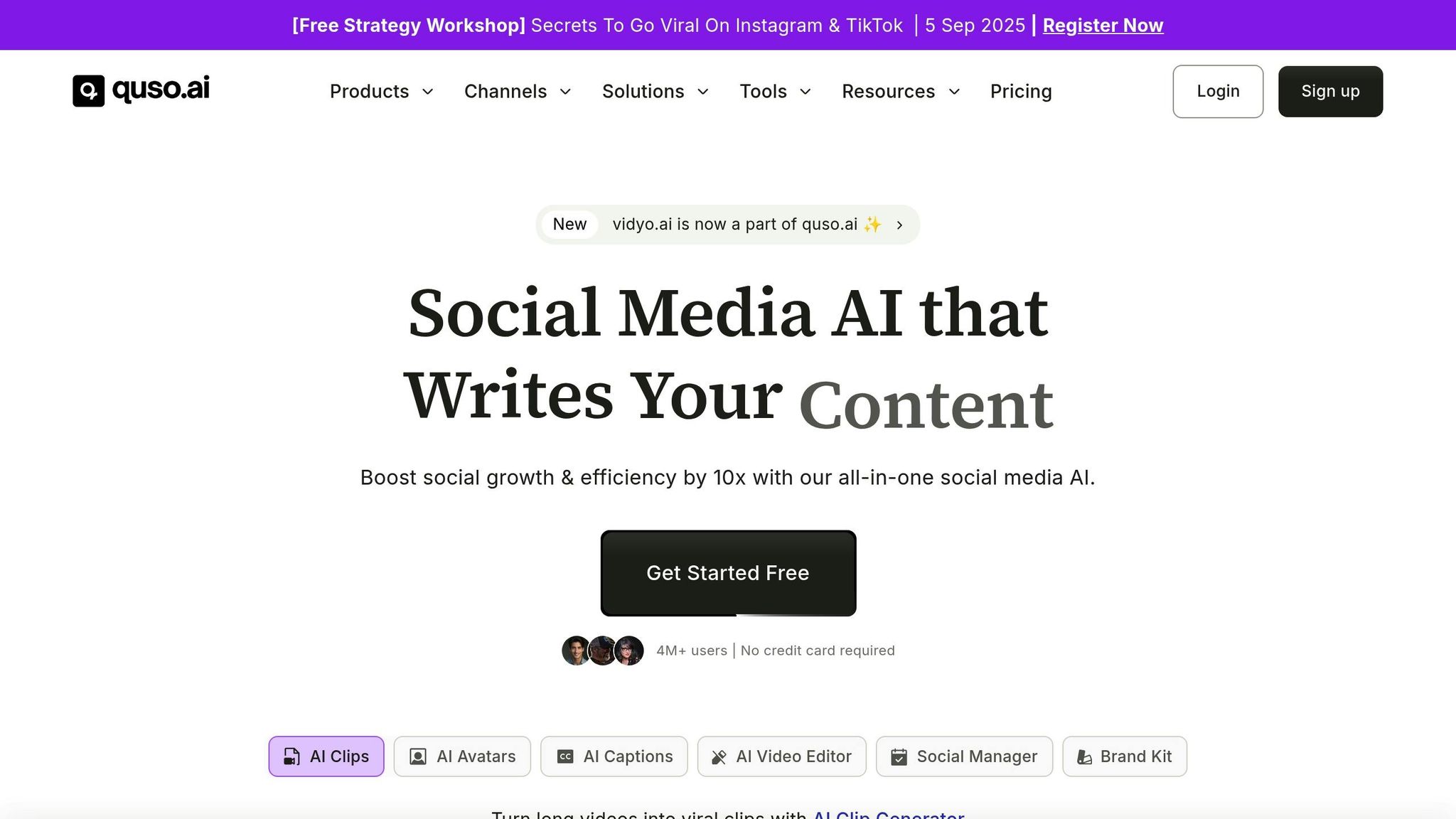
Vidyo.ai, now rebranded as Quso.ai, has evolved from a simple video editor into an all-in-one AI-powered social media toolkit, serving over 4 million users. Let’s dive into how Quso.ai transforms long-form videos into attention-grabbing social media clips.
Content Format Transformation Capabilities
Quso.ai specializes in turning long videos into short, shareable clips perfect for social media. From an hour-long video, the platform can generate 5–45 clips, cutting down editing time by 200%. This allows creators to spend more time on strategy and less on repetitive editing tasks.
The platform supports multiple video formats, including mp4, m4v, mov, and webm. You can upload files directly or use YouTube links through their beta feature. Once uploaded, the AI identifies the most engaging moments and creates platform-optimized clips.
Quso.ai offers four aspect ratios tailored to different platforms:
- Square (1:1) for Instagram posts
- Landscape (16:9) for YouTube
- Portrait (9:16) for TikTok and Instagram Stories
- Portrait Split (9:16) for specialized vertical content
It also uses AI-powered captions, which can boost video performance by up to 40%, making it easier to grab viewers' attention.
Multi-Channel Distribution Automation
Quso.ai doesn’t just stop at content creation - it also streamlines distribution. With built-in scheduling tools, you can plan and post content across multiple platforms simultaneously. The platform allows for video customization using AI avatars, text-to-speech features, and brand kits to ensure consistent branding.
For paid users, Quso.ai supports multiple languages, including Spanish, French, and German, in addition to English. This multilingual feature is ideal for businesses managing global campaigns or targeting international audiences.
Analytics and Performance Tracking
The Growth Plan includes advanced analytics to help users track performance and refine their strategies. These tools highlight top-performing clips, enabling creators to focus on what works best.
Real-world success stories underline its impact. Alessandro Cecere, Marketing Manager at Luxor, shared that Quso.ai helped boost their YouTube subscribers from 6,000 to 15,000 in just a few months. Wendy Richmond, CEO of Results Matter Dental Marketing, saw her YouTube views skyrocket by 2,000 times after integrating Quso.ai into her workflow.
"quso.ai has sped up our clip selection and creation process." – John Price, CMO of The Pediatric Experience
"With quso.ai, we cut down monthly editing time from 200 to 80 hours." – Ree Hurkan, Founder, ReeAnimate
Pricing and Scalability for Businesses
Quso.ai offers flexible pricing plans, with yearly subscriptions discounted by 50% compared to monthly rates:
- Free Plan ($0/month): Includes 75 processing credits renewed monthly, AI clips and captions, and 720p video downloads - a great option for testing the platform.
- Essential Plan ($39/month): Offers 300 credits, access to over 10 AI tools, and is ideal for small businesses or individual creators.
- Growth Plan ($49/month): Designed for scaling businesses, this plan includes 600 credits, unlimited scheduling, advanced analytics, and multiple brand kits for seamless branding.
- Custom Plans ($42–$83/month): Tailored for heavy users, these plans include higher processing limits and specialized features.
All paid plans support 1080p downloads and come with priority customer support. The credit system is straightforward - each credit equals about one minute of video processing, making it easy to estimate usage.
Seth Green, an Online Fitness Coach, shared that Quso.ai increased his productivity sevenfold. It’s a clear example of how the platform empowers content creators to scale their operations efficiently.
6. Outbrain
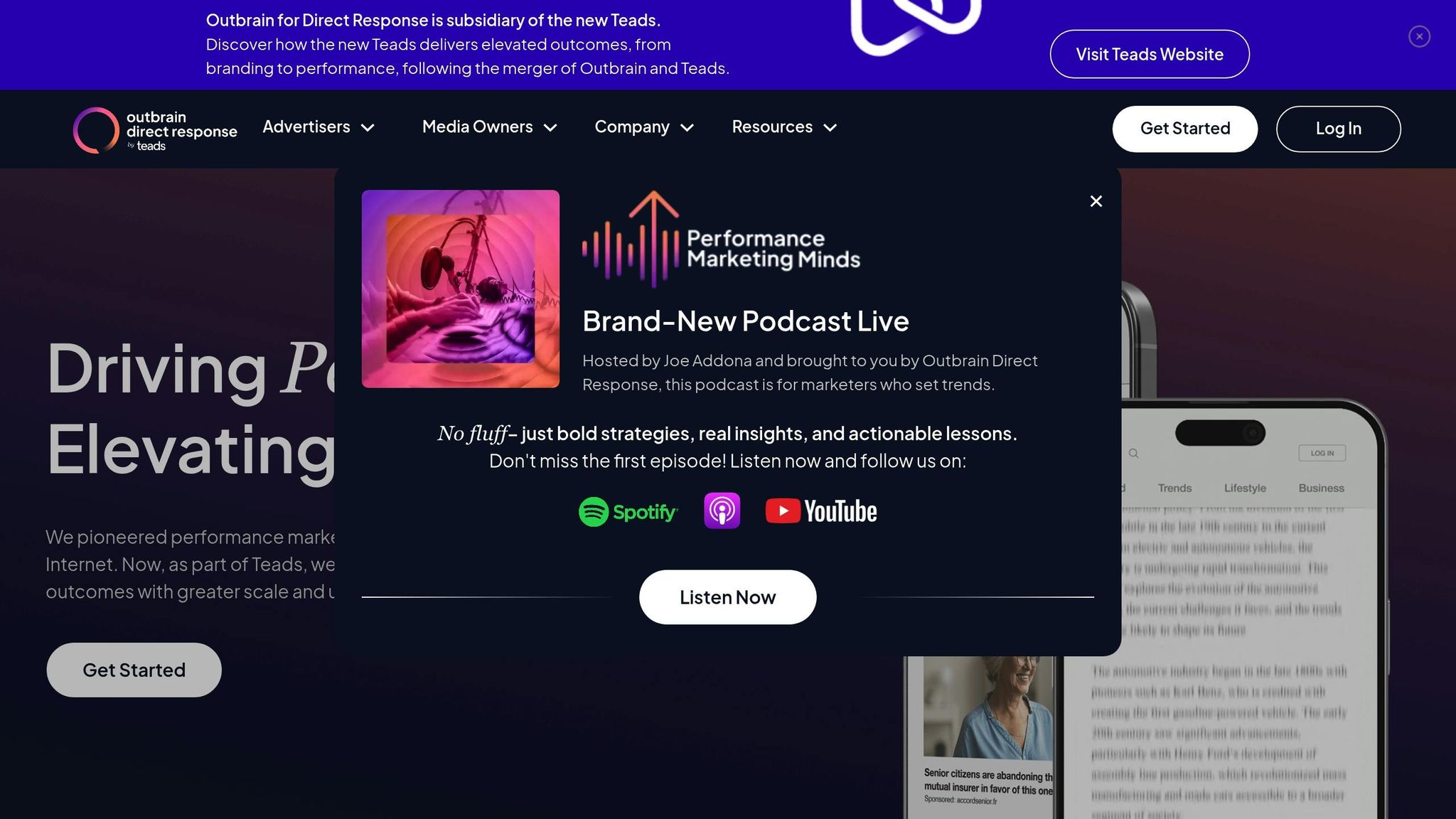
Outbrain is a native advertising platform that leverages AI to distribute content across a network of publishers. What sets Outbrain apart is how it integrates branded content directly into editorial pieces, making the experience feel more natural and less intrusive compared to traditional ads.
Smarter Multi-Channel Distribution
Using machine learning, Outbrain automates content distribution across devices - whether it's desktop, mobile, or tablet. This ensures your content is not only placed optimally but also reaches the most relevant audience, making campaign management more efficient.
Tracking Performance with Analytics
Outbrain provides detailed analytics to monitor important metrics like click-through rates, engagement, and conversions. These insights help marketers fine-tune their strategies by identifying which audience segments and content types resonate most effectively.
Flexible Pricing for Growing Businesses
Outbrain operates on a performance-based pricing model, which includes minimum spending requirements tailored for mid-sized and larger businesses. For enterprise clients, the platform offers additional perks like custom pricing, dedicated support, and API access for seamless integration with existing marketing tools.
Next, we’ll dive into another tool shaping the future of AI-powered content distribution.
7. Taboola
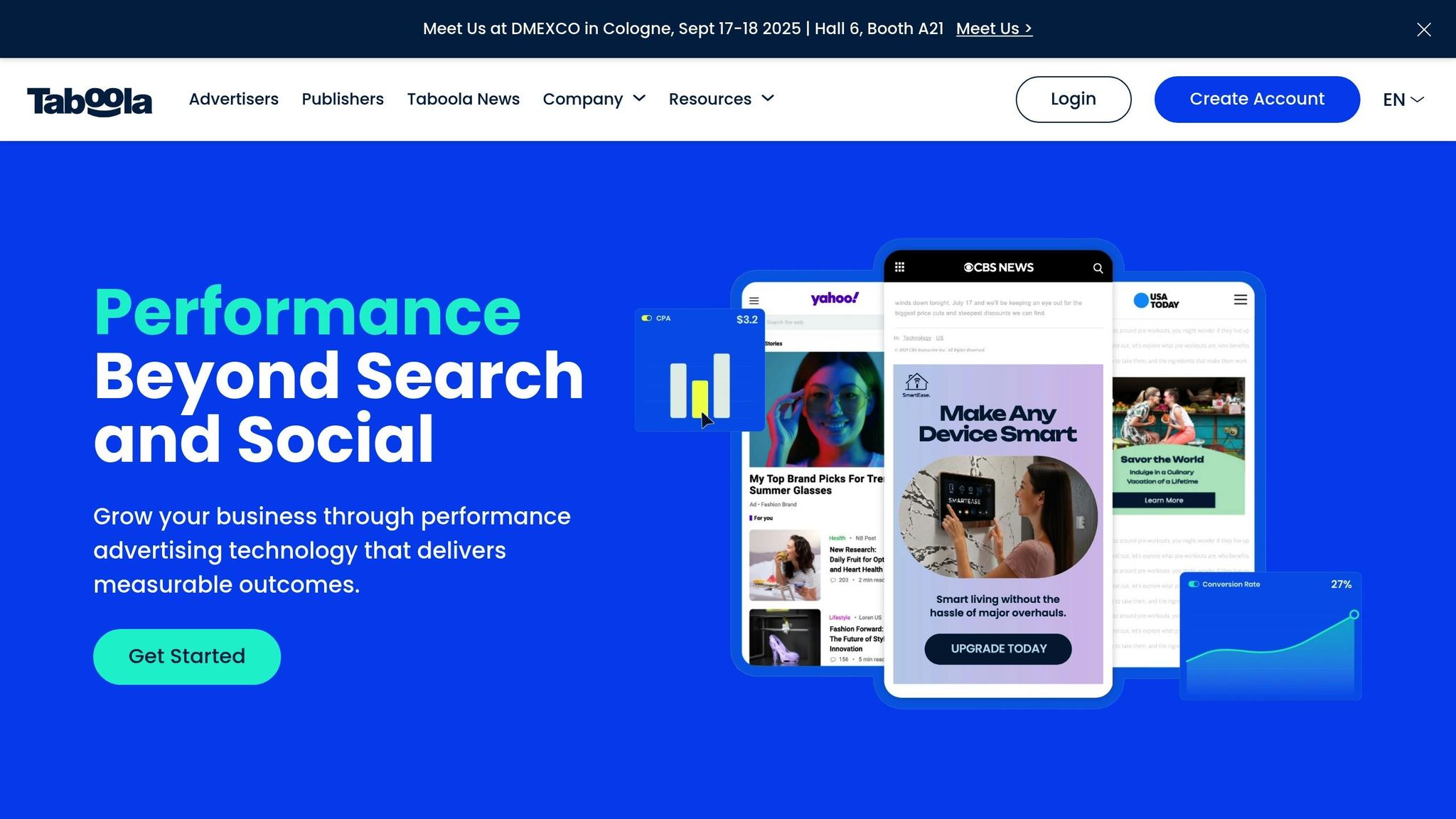
Closing our list is Taboola, a platform that brings automation to content distribution through its native advertising model.
Taboola serves as a content discovery platform, using advanced algorithms to deliver sponsored content seamlessly alongside editorial recommendations on high-profile publisher sites. This approach allows marketers to reach broad audiences in a way that feels organic and non-intrusive.
Automated Multi-Channel Distribution
Taboola’s technology takes the guesswork out of content placement by optimizing distribution across desktop, mobile, and tablet devices in real time. By analyzing user behavior, it adjusts bidding strategies based on factors like device type, time of day, and audience engagement levels.
One standout feature is its cross-device targeting. This ensures marketers can engage with the same users across different devices without needing to manually tweak campaigns. Additionally, it fine-tunes cost-per-click rates automatically, helping advertisers make the most of their budgets while maintaining consistent visibility.
Performance Tracking and Insights
Taboola provides a centralized dashboard packed with analytics tools to give advertisers a clear view of their campaign performance. Key metrics such as click-through rates, engagement duration, and conversion paths are all tracked, offering a deeper understanding of how audiences interact with the content.
The platform also shines in its ability to reveal audience demographics and content preferences, which can help marketers refine their strategies. For those who prefer a more integrated approach, Taboola works seamlessly with third-party analytics tools to offer a unified view of campaign data.
Flexible Pricing for Different Business Needs
Taboola operates on a cost-per-click model, making it a better fit for businesses with established advertising budgets. Larger advertisers can take advantage of managed services, which include dedicated account managers and advanced targeting options. Smaller businesses, meanwhile, can access Taboola’s network through a self-serve platform, with minimum spend requirements designed for those with more experience in advertising.
Tool Comparison Chart
Choosing the right AI content distribution tool depends on your specific needs, budget, and technical requirements. Each platform brings unique strengths tailored to different business goals and marketing strategies.
| Tool | Primary Focus | Key Strengths | Pricing Model | Best For |
|---|---|---|---|---|
| Distribution AI | Multi-platform automation | Cross-channel scheduling, analytics integration | Subscription-based | Businesses managing multiple social platforms |
| Narrato | Content creation & distribution | AI writing assistance, workflow management | Tiered monthly plans | Content teams needing end-to-end solutions |
| Synthesia | Video content creation | AI avatars, multilingual support | Per-video or monthly credits | Companies creating training or marketing videos |
| Pictory AI | Video content from text | Automatic video generation, stock footage | Credit-based system | Marketers converting blog posts to video |
| Vidyo.ai | Short-form video creation | Long-form to short-form conversion | Usage-based pricing | Social media managers creating clips |
| Outbrain | Native advertising | Premium publisher network, audience targeting | Cost-per-click (CPC) | Brands seeking quality traffic and engagement |
| Taboola | Content discovery | Cross-device targeting, real-time optimization | Cost-per-click (CPC) | Advertisers with established budgets |
This chart highlights the core benefits of each tool. Below, we break down the key factors to consider when selecting the right platform for your business.
Budget Considerations
Your budget plays a major role in deciding which tool fits best. Subscription-based platforms, such as Narrato or Distribution AI, offer predictable costs, typically ranging from $29 to $299 per month. On the other hand, credit-based systems like Pictory AI or Synthesia provide flexibility but can become pricier with frequent use. For native advertising tools like Outbrain or Taboola, costs depend on your campaign's click volume, making them suitable for businesses with larger ad budgets.
Technical Complexity
Ease of use varies widely across platforms. Tools like Narrato and Distribution AI are beginner-friendly, requiring little technical know-how. Video creation platforms, such as Synthesia, may involve a steeper learning curve due to their advanced features. Native advertising tools, including Taboola and Outbrain, require expertise in campaign setup and optimization.
Content Type Compatibility
The type of content you focus on should guide your choice. Text-heavy strategies align well with Narrato and Distribution AI, while video-focused marketers will benefit more from tools like Pictory AI or Vidyo.ai. If your goal is to drive traffic through native advertising, Outbrain and Taboola are ideal.
Scale Requirements
The size and scope of your business also matter. Small businesses often find single-purpose tools sufficient, while larger enterprises benefit from platforms offering a wider range of features. For instance, native advertising platforms like Outbrain and Taboola are best suited for companies with ad budgets exceeding $1,000 per month.
Integration Capabilities
Efficiency improves when tools integrate seamlessly with your existing systems. Distribution AI stands out for its broad compatibility with third-party platforms, making it a great choice for streamlining workflows. Video creation tools, however, may require additional steps to fit into your current processes.
Learning Curves
The time it takes to master a tool should also influence your decision. Social media automation tools like Distribution AI are quick to learn, often taking just a few days. Video platforms such as Synthesia or Pictory AI may require weeks to fully grasp. Native advertising tools demand ongoing effort and expertise to optimize campaigns effectively.
This comparison provides a clear overview of how different tools align with various business needs, helping you craft a content distribution strategy that supports your goals.
Conclusion
AI-powered content distribution tools have reshaped the way businesses scale their marketing strategies. In 2023, marketers reported a 70% boost in ROI and 58% higher sales thanks to these advanced tools.
These platforms do more than just simplify workflows - they break through the old barriers of personalization. Where manual distribution often led to inconsistent results, AI now makes it possible to repurpose content into various formats, tailor it for specific audience segments, and fine-tune delivery schedules to maximize engagement.
One of the biggest draws? Cost savings. By reducing the need for manual labor and delivering results more efficiently, AI-powered tools help businesses achieve more while spending less. Whether it’s automating social media posts or transforming written content into engaging videos, these tools take care of the heavy lifting.
Adopting AI-powered content distribution isn’t just about staying current - it’s about setting your business up to thrive in a marketing world that’s increasingly driven by automation.
FAQs
How do AI tools like Distribution AI and Narrato make content distribution more efficient across platforms?
AI tools such as Distribution AI and Narrato make content distribution easier and more efficient by automating tedious tasks and refining workflows. Take Narrato, for example - its AI-powered features let users publish content across multiple platforms directly, saving time and ensuring consistent messaging. Similarly, Distribution AI leverages automation to personalize content delivery, curate relevant materials, and manage large-scale distribution with ease.
By simplifying the distribution process, these tools help marketers connect with their target audience more effectively, boost engagement, and ensure content is delivered on time across various channels.
What should businesses look for when selecting an AI tool for content distribution?
When choosing an AI tool for content distribution, it's essential to prioritize its capability to analyze audience behavior, pinpoint the most effective platforms, and identify the best times to post. Equally important is ensuring the tool offers in-depth performance tracking across various channels.
Look for features such as personalization, real-time feedback, and predictive modeling to ensure the tool aligns well with your content strategy and engagement objectives. These functionalities can play a key role in expanding your reach and boosting the impact of your campaigns.
What are the different pricing models for AI content distribution tools, and how can businesses plan their budgets effectively?
AI content distribution tools come with different pricing structures, such as subscription plans, usage-based pricing, fixed fees, or tiered options. Each of these models affects your expenses in unique ways, so it’s important to choose one that matches your business goals and financial plans.
When planning your budget, think about potential additional costs, like integration fees or customer support charges. Also, evaluate the tool's scalability and how well it aligns with your long-term strategy. Pay attention to the total cost of ownership, which includes ongoing operational costs, and look for pricing options that can adapt as your business grows. This way, you can make the most of your investment while keeping your spending in check.
